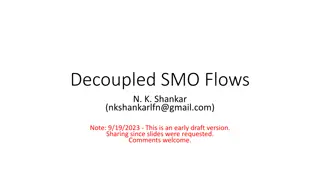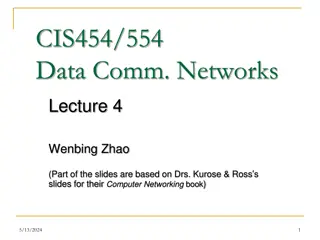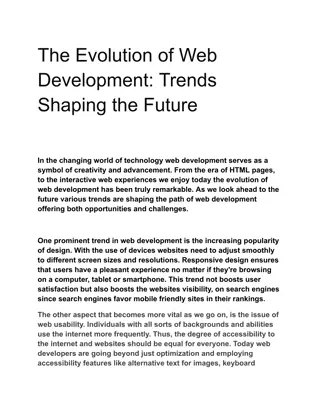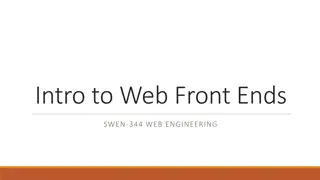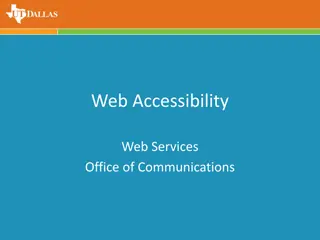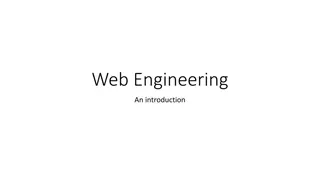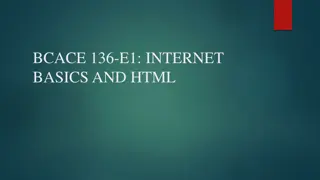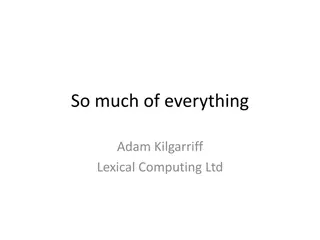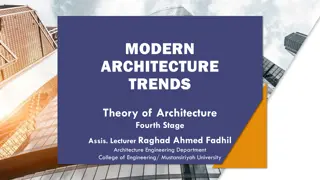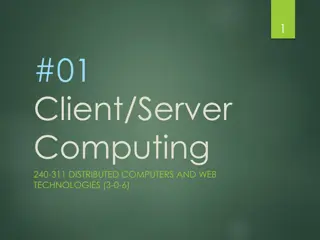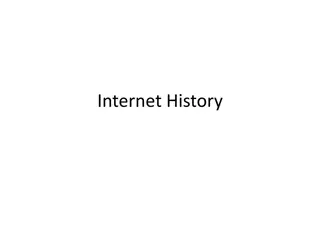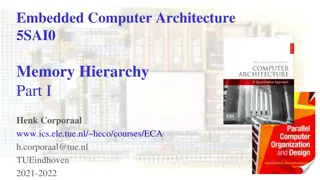Evolution of Web Architecture
The evolution of the Web architecture is explored in this informative content. From the early days characterized by HTTP and HTML to addressing scalability challenges and ensuring consistent component integration, the Web's growth and structure are detailed. Understanding the essence of the Web as a distributed information system and the concept of resources is key to grasping its architecture.
Download Presentation

Please find below an Image/Link to download the presentation.
The content on the website is provided AS IS for your information and personal use only. It may not be sold, licensed, or shared on other websites without obtaining consent from the author.If you encounter any issues during the download, it is possible that the publisher has removed the file from their server.
You are allowed to download the files provided on this website for personal or commercial use, subject to the condition that they are used lawfully. All files are the property of their respective owners.
The content on the website is provided AS IS for your information and personal use only. It may not be sold, licensed, or shared on other websites without obtaining consent from the author.
E N D
Presentation Transcript
The Architecture of the World Wide Web COMP3220 Web Infrastructure Dr Nicholas Gibbins nmg@ecs.soton.ac.uk
The evolving architecture of the Web In its earliest days, the Web was defined primarily in terms of its implementation HTTP was what Web browsers and Web servers spoke HTML was what Web browsers read As the Web grew, this became an increasing problem Network issues with early HTTP affected scalability Nature of application interactions on the Web changed (images, etc) Limited support for shared caching The Web architecture addresses this by answering the following questions: How do all the Web components fit together in a consistent manner? How should future components fit together with the rest of the Web? 3
To properly understand the Web architecture, we need to understand what the Web is To properly understand what the Web is, we need to understand how the Web came to be 4
What is the Web? The Web is a distributed information system that provides access to hypertext documents and other objects of interest We have a general name for these objects of interest: resources 5 5
What is a resource? The earliest formal uses of the term "resource" in an Internet context date from 1994 Synonymous with "file" or "network object" Earliest reference to resources in IETF RFCs is in RFC1580 from March 1994 First formal definition of Uniform Resource Identifiers in RFC1630 from June 1994 Earlier documents submitted by Berners-Lee to IETF talked about documents EARN Staff (1994) Guide to Network Resource Tools. RFC1580. Available online at https://tools.ietf.org/html/rfc1580 Berners-Lee, T. (1994) Universal Resource Identifiers in WWW: A Unifying Syntax for the Expression of Names and Addresses of Objects on the Network as used in the World-Wide Web. RFC1630. Available online at https://tools.ietf.org/html/rfc1630 6
What is a resource? Familiar examples [of resources] include an electronic document, an image, a source of information with a consistent purpose (e.g., today's weather report for Los Angeles ), a service (e.g., an HTTP-to-SMS gateway), and a collection of other resources. A resource is not necessarily accessible via the Internet; e.g., human beings, corporations, and bound books in a library can also be resources. Likewise, abstract concepts can be resources, such as the operators and operands of a mathematical equation, the types of a relationship (e.g., parent or employee ), or numeric values (e.g., zero, one, and infinity). Berners-Lee, T. et al (2005) Uniform Resource Identifier (URI): Generic Syntax. RFC3986. Available online at https://tools.ietf.org/html/rfc3986 7 7
What is a resource? Familiar examples [of resources] include an electronic document, an image, a source of information with a consistent purpose (e.g., today's weather report for Los Angeles ), a service (e.g., an HTTP-to-SMS gateway), and a collection of other resources. A resource is not necessarily accessible via the Internet; e.g., human beings, corporations, and bound books in a library can also be resources. Likewise, abstract concepts can be resources, such as the operators and operands of a mathematical equation, the types of a relationship (e.g., parent or employee ), or numeric values (e.g., zero, one, and infinity). A resource may change over time yet still be considered the same resource The Ship of Theseus/my grandfather's axe/Trigger's broom Berners-Lee, T. et al (2005) Uniform Resource Identifier (URI): Generic Syntax. RFC3986. Available online at https://tools.ietf.org/html/rfc3986 8 8
What is a resource? Familiar examples [of resources] include an electronic document, an image, a source of information with a consistent purpose (e.g., today's weather report for Los Angeles ), a service (e.g., an HTTP-to-SMS gateway), and a collection of other resources. A resource is not necessarily accessible via the Internet; e.g., human beings, corporations, and bound books in a library can also be resources. Likewise, abstract concepts can be resources, such as the operators and operands of a mathematical equation, the types of a relationship (e.g., parent or employee ), or numeric values (e.g., zero, one, and infinity). A resource may not be something which can be "retrieved" Can still be interacted with over the network Berners-Lee, T. et al (2005) Uniform Resource Identifier (URI): Generic Syntax. RFC3986. Available online at https://tools.ietf.org/html/rfc3986 9 9
What is a resource? Familiar examples [of resources] include an electronic document, an image, a source of information with a consistent purpose (e.g., today's weather report for Los Angeles ), a service (e.g., an HTTP-to-SMS gateway), and a collection of other resources. A resource is not necessarily accessible via the Internet; e.g., human beings, corporations, and bound books in a library can also be resources. Likewise, abstract concepts can be resources, such as the operators and operands of a mathematical equation, the types of a relationship (e.g., parent or employee ), or numeric values (e.g., zero, one, and infinity). A resource may not even be something that's "on the Internet" Berners-Lee, T. et al (2005) Uniform Resource Identifier (URI): Generic Syntax. RFC3986. Available online at https://tools.ietf.org/html/rfc3986 10 10
Resource today s BBC weather forecast for Southampton 11 11
Architectural Bases of the Web The notion of a resource is central to the architecture of the Web We need to be able to: identify them represent them interact with them These are orthogonal considerations 12 12
Identification URI We need a way to identify resources Machines need to be able to resolve those identifiers (to "fetch" the resource) Humans should (ideally) be able to read and write those identifiers http://www.bbc.co.uk/weather/2637487 Resource today s BBC weather forecast for Southampton Uniform Resource Identifiers Arguably the single most important contribution of the Web 13 1 3
Representation A representation is data that encodes information about resource state. Resource Representations do not necessarily describe the resource, or portray a likeness of the resource, or represent the resource in other senses of the word "represent". today s BBC weather forecast for Southampton Representation Metadata: Content-Type: text/html Data: <html> <head> <title>BBC Weather Southampton</title> ... </html> 14 14
Representation Representation Metadata: Content-Type: video/mp4 A representation is data that encodes information about resource state Data: Resource Representations do not necessarily describe the resource, or portray a likeness of the resource, or represent the resource in other senses of the word "represent" today s BBC weather forecast for Southampton Representation Metadata: Content-Type: text/html Data: <html> <head> <title>BBC Weather Southampton</title> ... </html> May be multiple representations of a given resource 15 15
Interaction URI Resource representations are transmitted using interaction protocols. http://www.bbc.co.uk/weather/2637487 Resource accesses The interactions between Web agents and resources are defined in terms of protocols that specify the exchange of messages today s BBC weather forecast for Southampton Representation Metadata: Content-Type: text/html Data: <html> <head> <title>BBC Weather Southampton</title> ... </html> 16 1 6 16
Representational State Transfer The core Web architecture was heavily informed by the work of Roy Fielding Co-author of HTTP and URI RFCs Co-founder of the Apache Software Foundation Fielding defined an architectural style known as representational state transfer or REST What data elements exist? What components (i.e. processing elements) exist? What constraints apply to the interactions between components? Fielding, R.T. (2000) Architectural Styles and the Design of Network-based Software Architectures. PhD Thesis. University of California at Irvine. Available online at http://www.ics.uci.edu/~fielding/pubs/dissertation/top.htm 17
Data Elements Resources Identifiers (URIs, etc) Representations (HTML, etc) Metadata (resource, representation, control) 18
Components Origin servers Definitive source of resource representations Web server: Apache, nginx, IIS, etc Gateways Intermediary selected by origin server Often used to integrate legacy services Proxies Intermediary selected by user agent Filter, cache, etc User agents Browser: Chrome, IE, Safari, Firefox, etc 19 19
Components User Agent Origin Server Proxy Gateway Cache 20
Constraints Client-Server Separation of concerns: user interface (client) data storage (server) + Improves portability of user interface + Improves scalability by simplifying server + Allows components to evolve separately 21
Constraints Client-Server Each request from client to server must contain all of the information necessary to understand the request No context is stored on the server Session state is kept entirely on the client Stateless + Improves visibility (can consider each request in isolation) + Improves reliability (easier to recover from partial failures) + Improves scalability (reduces server resource usage) Increases per-interaction overhead 22
Constraints Client-Server Response data must be labelled as cacheable or non-cacheable If cacheable, client may reuse response data for later requests Stateless Caching + Allows some interactions to be eliminated + Reduces average latency of interactions Stale data reduces reliability 23
Constraints Client-Server Uniform interface between components Identification of resources Manipulation of resources through representations Self-descriptive messages Hypermedia as the engine of application state (HATEOAS) Stateless Caching Uniform Interface +Improves visibility of interactions +Encourages independent evolvability -Degrades efficiency (depending on optimisation) 24
Constraints Client-Server System components have no knowledge of components beyond those with which they directly interact Encapsulate legacy services Introduce intermediaries Stateless Caching Uniform Interface Layered +Limits system complexity +Improves scalability (load balancing) -Adds latency and overhead (offset by caching) 25
Constraints Client-Server Client functionality extended by downloading and executing code Applets Scripts Stateless Caching Uniform Interface Layered +Improves extensibility Code on Demand (optional) -Reduces visibility 26
Further Reading Architecture of the World Wide Web, Volume One http://www.w3.org/TR/webarch/ Architectural Styles and the Design of Network-based Software Architectures, Ch. 4-5 http://www.ics.uci.edu/~fielding/pubs/dissertation/top.htm 27 27


